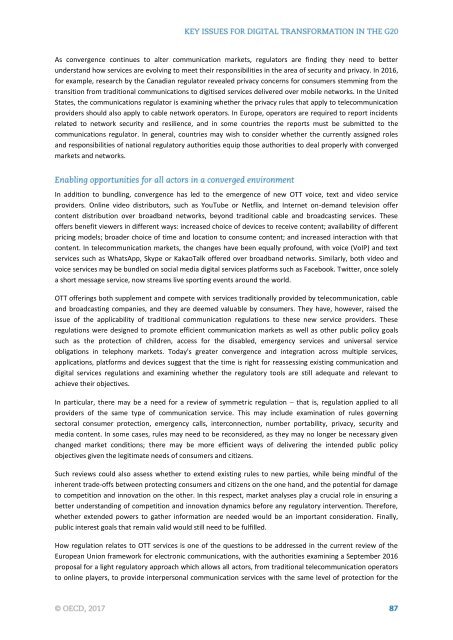KEY ISSUES FOR DIGITAL TRANSFORMATION IN THE G20
2jz0oUm
2jz0oUm
Create successful ePaper yourself
Turn your PDF publications into a flip-book with our unique Google optimized e-Paper software.
As convergence continues to alter communication markets, regulators are finding they need to better<br />
understand how services are evolving to meet their responsibilities in the area of security and privacy. In 2016,<br />
for example, research by the Canadian regulator revealed privacy concerns for consumers stemming from the<br />
transition from traditional communications to digitised services delivered over mobile networks. In the United<br />
States, the communications regulator is examining whether the privacy rules that apply to telecommunication<br />
providers should also apply to cable network operators. In Europe, operators are required to report incidents<br />
related to network security and resilience, and in some countries the reports must be submitted to the<br />
communications regulator. In general, countries may wish to consider whether the currently assigned roles<br />
and responsibilities of national regulatory authorities equip those authorities to deal properly with converged<br />
markets and networks.<br />
In addition to bundling, convergence has led to the emergence of new OTT voice, text and video service<br />
providers. Online video distributors, such as YouTube or Netflix, and Internet on-demand television offer<br />
content distribution over broadband networks, beyond traditional cable and broadcasting services. These<br />
offers benefit viewers in different ways: increased choice of devices to receive content; availability of different<br />
pricing models; broader choice of time and location to consume content; and increased interaction with that<br />
content. In telecommunication markets, the changes have been equally profound, with voice (VoIP) and text<br />
services such as WhatsApp, Skype or KakaoTalk offered over broadband networks. Similarly, both video and<br />
voice services may be bundled on social media digital services platforms such as Facebook. Twitter, once solely<br />
a short message service, now streams live sporting events around the world.<br />
OTT offerings both supplement and compete with services traditionally provided by telecommunication, cable<br />
and broadcasting companies, and they are deemed valuable by consumers. They have, however, raised the<br />
issue of the applicability of traditional communication regulations to these new service providers. These<br />
regulations were designed to promote efficient communication markets as well as other public policy goals<br />
such as the protection of children, access for the disabled, emergency services and universal service<br />
obligations in telephony markets. Today's greater convergence and integration across multiple services,<br />
applications, platforms and devices suggest that the time is right for reassessing existing communication and<br />
digital services regulations and examining whether the regulatory tools are still adequate and relevant to<br />
achieve their objectives.<br />
In particular, there may be a need for a review of symmetric regulation that is, regulation applied to all<br />
providers of the same type of communication service. This may include examination of rules governing<br />
sectoral consumer protection, emergency calls, interconnection, number portability, privacy, security and<br />
media content. In some cases, rules may need to be reconsidered, as they may no longer be necessary given<br />
changed market conditions; there may be more efficient ways of delivering the intended public policy<br />
objectives given the legitimate needs of consumers and citizens.<br />
Such reviews could also assess whether to extend existing rules to new parties, while being mindful of the<br />
inherent trade-offs between protecting consumers and citizens on the one hand, and the potential for damage<br />
to competition and innovation on the other. In this respect, market analyses play a crucial role in ensuring a<br />
better understanding of competition and innovation dynamics before any regulatory intervention. Therefore,<br />
whether extended powers to gather information are needed would be an important consideration. Finally,<br />
public interest goals that remain valid would still need to be fulfilled.<br />
How regulation relates to OTT services is one of the questions to be addressed in the current review of the<br />
European Union framework for electronic communications, with the authorities examining a September 2016<br />
proposal for a light regulatory approach which allows all actors, from traditional telecommunication operators<br />
to online players, to provide interpersonal communication services with the same level of protection for the


